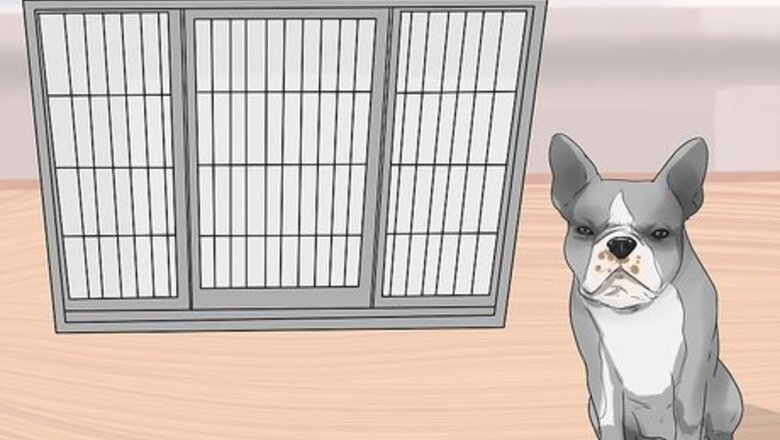
views
X
Research source
Boston Terriers can be stubborn, though, which could make training your Boston Terrier somewhat challenging.[2]
X
Research source
No need to worry—with time, patience, and persistence, you can train your Boston Terrier and turn him into a well-behaved and loving companion.
Crate Training Your Boston Terrier
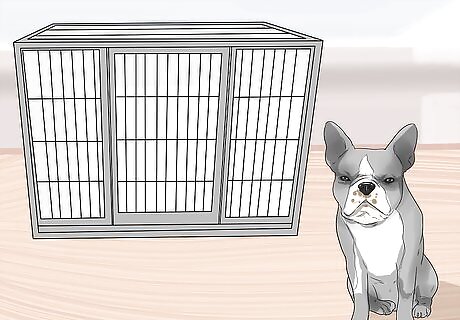
Pick the right-sized crate for your Boston Terrier. Crate training is an important component of training your Boston Terrier. It will not only help with house training, but also allow him to see his crate as a place of safety and comfort. His crate should be large enough for him to stand up and move around in, but not so large that he can create a separate ‘bathroom’ space. The ideal crate size for Boston Terriers is 24 x 30 inches (61 x 76 cm) or 24 x 36 inches (61 x 91 cm).
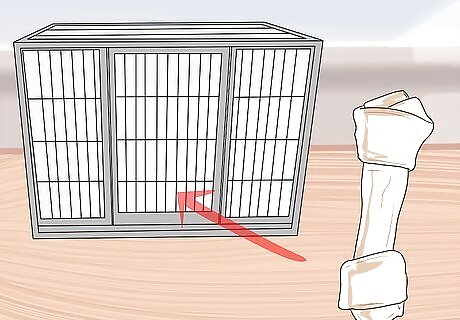
Create a comfortable environment inside the crate. To make the crate look more inviting to your Boston Terrier, put some ‘creature comforts’ inside of it, including comfortable bedding, his water bowl and some toys. The bowl should be sturdy enough that he can’t tip it over. Some of the toys should be chew toys so he can learn what he should chew on (instead of your shoes or furniture). Boston Terriers love to chew. Crate training your Boston Terrier can prevent him from being destructive in your home when you are not home. Examples of good chew toys are high-impact rubber balls and rawhide chew toys.
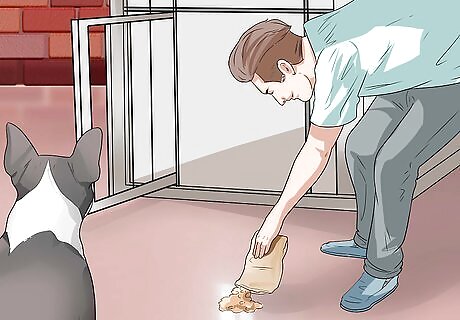
Lure your Boston Terrier inside the crate. Your Boston Terrier may be a little hesitant to enter the crate at first. To encourage him to go in, place some food kibbles or dog biscuits in the crate. You may want to lure him inside in phases: at mealtime, place his food bowl just outside the crate, then in the doorway, then the back of the crate. When your Boston Terrier enters the crate on his own, reward him with lots of verbal praise and maybe even a treat. The more positive reinforcement he gets from you, the more he will make a positive association with being inside the crate. Initially, it may help to leave the crate door open so he can enter the crate whenever he wants. As your Boston Terrier becomes more comfortable with entering the crate, consider adding a verbal command, such as ‘kennel.’ When he goes in after he hears your command, immediately give him a treat and verbal praise. Be patient with your Boston Terrier. It may take some time for him to enter the crate on his own. Work at his pace.
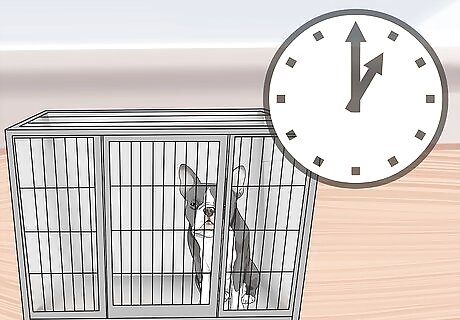
Crate your Boston Terrier for short periods. When your Boston Terrier can enter the crate on his own, begin closing its door and leaving him inside. Close the door for a few seconds, wait for him to calm down (if necessary), then open the door again and give him a treat and verbal praise. You can then work on closing the door, leaving the room, then returning at random time intervals. Gradually work up to leaving your Boston Terrier in the crate overnight. If you have a puppy, remember that he can’t hold his bladder for very long—you will still need to take him outside regularly to eliminate. Boston Terriers can develop separation anxiety, so proper crate training can help him feel calm and comfortable when you are not home.
House Training Your Boston Terrier
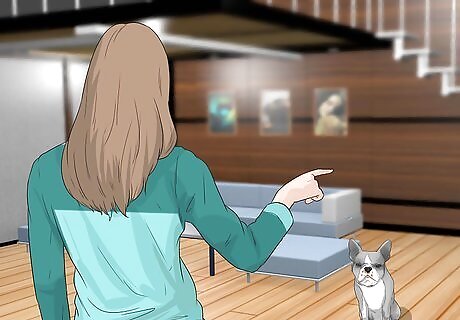
Start house training as early as possible. The sooner you can start house training your Boston Terrier, the better. Fortunately, Boston Terriers tend to be very tidy dogs, so your Boston Terrier probably will not want to make a mess in your home. It may help to keep him confined to a small area (e.g., small bedroom) in your home until he is fully house trained. If a small bedroom is not available, consider using baby gates to section off a portion of a larger room. It may take up to 6 months to house train your Boston Terrier, so be patient with him.
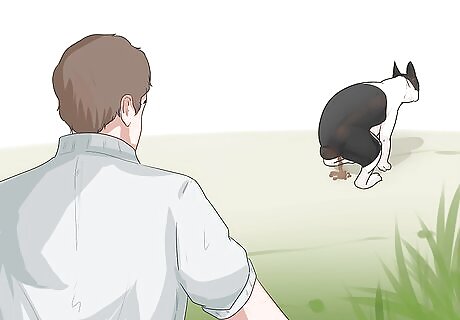
Select an outdoor ‘bathroom spot’ for your Boston Terrier. Your Boston Terrier should go to the bathroom outside, in the same spot. By having an established bathroom area, your Boston Terrier will be able to leave his scent in the area and make it his territory. If you have a puppy, you may need to set up an indoor bathroom spot in the confined area where he can eliminate when you are away from home. You can use newspapers in the bathroom spot. Keep in mind that this may prolong housetraining.

Establish and maintain a regular bathroom schedule. Boston Terriers do best when they have a steady routine. With a regular bathroom schedule, your Boston Terrier will learn when he should go to the bathroom. If you have a puppy, take him outside after his first meal of the day, and each time he wakes up from a long nap. Other times to take your Boston Terrier out are after drinking water and playing. Keep in mind that a puppy can hold his bladder for about 1 hour per month of age, up to 12 months. Adult Boston Terriers do not need to eliminate as frequently as puppies, but should still be on a set bathroom schedule.
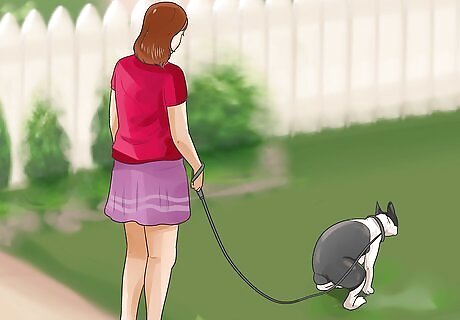
Put your Boston Terrier on a leash when you take him outside. If you have a backyard, it may be tempting to simply open the door and let your Boston Terrier outside to go to the bathroom. However, he may not eliminate that way, making an indoor bathroom accident more likely. During house training, put your Boston Terrier on a leash and walk him outside to your backyard.
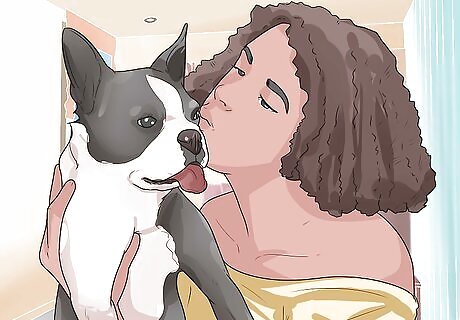
Reward your Boston Terrier when he eliminates outside. Since Boston Terriers aim to please, your own Boston Terrier will need your praise when he goes to the bathroom outside. Give him plenty of verbal praise (‘Good boy!’ or ‘Good job!’) after he finishes eliminating. You could also give him a small bit of a tasty treat.

Clean up accidents without punishing your Boston Terrier. Don’t be surprised if your Boston Terrier pees or poops in your home during house training. If you catch him in the act, say ‘No!’ firmly, pick him up, put him on leash, and take him outside. If you see the accident after the fact, clean it up with an enzymatic cleaner that will remove the odor and prevent him from going in the same spot again. Reward your Boston Terrier when he finishes eliminating outside. This positive reinforcement will encourage him to wait until he is outside to eliminate. Do not rub your Boston Terrier’s face in the urine or feces. This will not teach him that he’s done something wrong, since he will not associate the punishment with what he did. In fact, this may make him fearful of you.
Teaching Your Boston Terrier Basic Commands
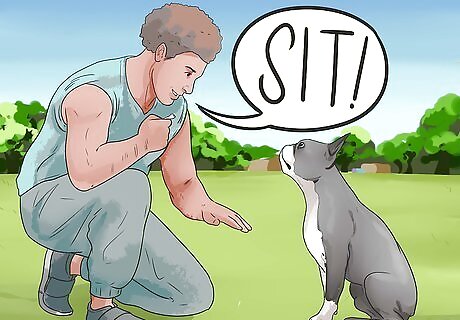
Teach your Boston Terrier one command at a time. Although your Boston Terrier is very intelligent, he may become confused if you try to teach him multiple commands at once. If he becomes confused, he may also become discouraged and want to quit training. It is better for him to completely master one command before moving on to the next. Basic commands include sit, stay, and heel. Enrolling your Boston Terrier in an obedience class can help you teach these basic commands. Ask your veterinarian or other dog owners for recommendations on good obedience classes.

Limit the number of repetitions of each command. It may take your Boston Terrier only a few tries before he masters a particular command. If that is the case, simply move on to the next command. Since Boston Terriers can become discouraged if they have to do the same thing numerous times, stop teaching a command as soon your Boston Terrier masters it.
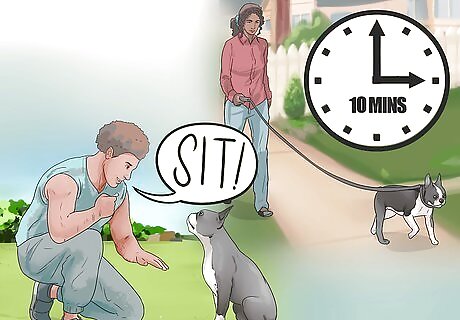
Keep training sessions short. Daily training will help your Boston Terrier learn and master commands more quickly. However, since dogs have short attention spans, your training sessions should be no more than about 10 minutes. You can have multiple training sessions in a day as long as you keep them short and allow long breaks in between.

Use positive reinforcement. Consistent and immediate positive reinforcement is essential to training a Boston Terrier. Each time your Boston Terrier correctly responds to a command, reward him with a treat and verbal praise. Give the treat within about 2 to 4 seconds of him following the command so he knows for what he is being rewarded. Always use verbal praise when giving your Boston Terrier the treat. That way, he will learn to associate praise with treats. Boston Terriers are motivated by treats. Choose dog treats that your Boston Terrier can eat quickly and easily (nothing too crunchy).
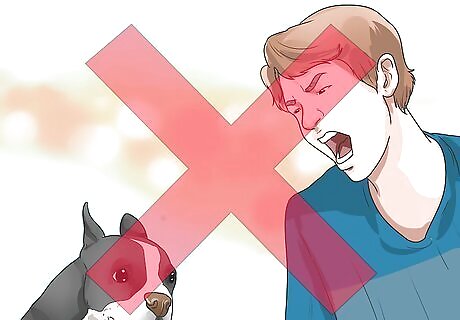
Speak to your Boston Terrier in a positive tone of voice. Boston Terriers can be very sensitive to tone of voice. Shouting at your Boston Terrier, or using an angry-sounding tone, can be discouraging to him, causing him to shut down. Keep your tone bright and positive, yet firm. Do not raise your voice at your Boston Terrier, even if you become angry or frustrated. A loud tone of voice may scare him.
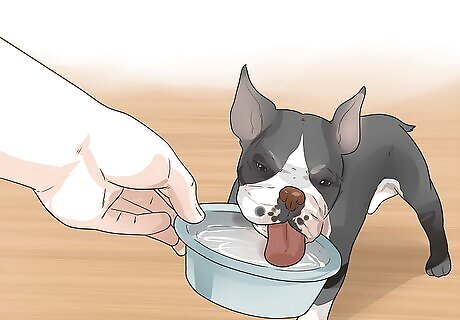
Train your Boston Terrier indoors during extreme weather. Boston Terriers can have trouble breathing, since their faces are short and compressed. For this reason, train your Boston Terrier inside when it is hot, humid, or very cold outside. If you do work with him outside in extreme weather, give him access to plenty of water and limit your training sessions to 10 to 15 minutes.
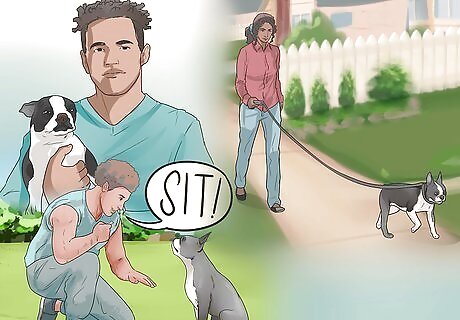
Train your Boston Terrier throughout his life. Lifelong training will help your Boston Terrier remember how to be a well-behaved dog. Even if he mastered every command you taught him, he will need continual training to ensure he doesn’t forget what he learned. After about 3 to 6 months of basic training, you can start teaching your Boston Terrier tricks, such as rolling over and playing dead.


















Comments
0 comment